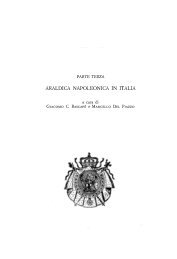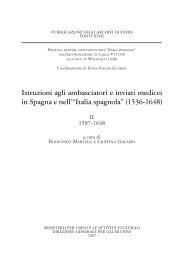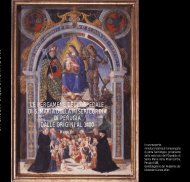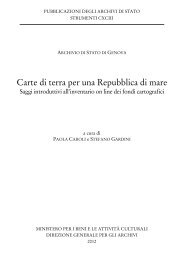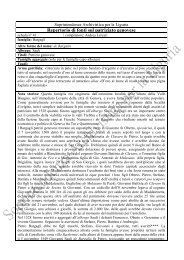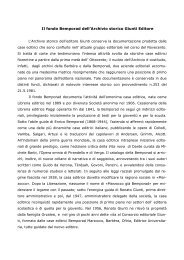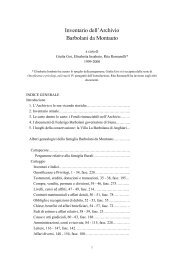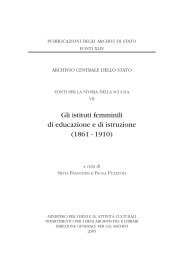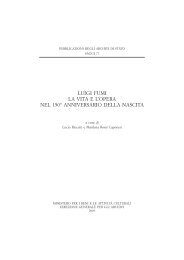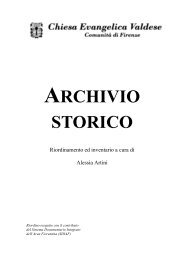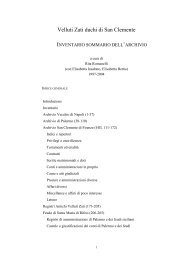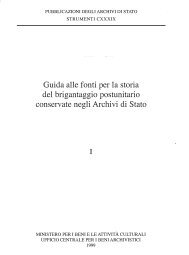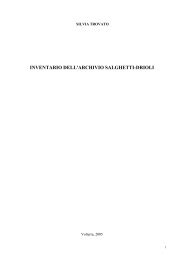ITALIA JUDAICA - Direzione generale per gli archivi
ITALIA JUDAICA - Direzione generale per gli archivi
ITALIA JUDAICA - Direzione generale per gli archivi
You also want an ePaper? Increase the reach of your titles
YUMPU automatically turns print PDFs into web optimized ePapers that Google loves.
140 Abraham Melamed<br />
.<br />
Te second development was external: the humanist culture in Italy, and<br />
m part1cular the development of Renaissance historiography, which provided<br />
J ewish scholars with a new conceptual framework in which to consider the<br />
meaning of Jewish history and its destination. The coincidence of these two<br />
developments provided the basis for a new approach to Jewish history. According<br />
to this opinion, it was not at ali accidental that the Jewish historiography<br />
of this <strong>per</strong>iod flourished mainly in Italy, where these two developments<br />
coincided. Some of the great historians of the <strong>per</strong>iod were J ewish exiles from<br />
Spain and Portugal and their descendants who settled in Italy. Towards the<br />
end of the sixteenth century, some native-horn Italian Jewish thinkers joined<br />
the debate about the course and meaning of Jewish history 3•<br />
Foliowing Shulvass' enthusiasm about the extent to which Renaissance<br />
culture influenced the various aspects of J ewish life, including the historical<br />
outlook, Baer almost obsessively searched for the influence of Renaissance<br />
historiography in his studies of the historical viewpoints of Abravanel and<br />
Ibn Verga 4 •<br />
However, Netanyahu has already shown that the sources of Abravanel's<br />
historical worldview are mainly to be sought in medieval theology rather then<br />
in Renaissance historiography 5• Clearly, Abravanel, who, at the end of the<br />
fìfteenth century, in old age, settled in Italy, could not be as yet meaningfuliy<br />
influenced by Renaissance historiography as it was stili in the early stages<br />
of its development. It is possible, however, to detect some influences from<br />
the broad spectrum of Renaissance humanist ideas upon his politica! and<br />
historical observations 6•<br />
As for Ibn Verga, Baer assumed that after the expulsion of the Jews<br />
from Portugal he carne to Italy where he wrote his Shebeth Yehudah under<br />
the influence of Renaissance culture, including his contemporaries Machiavelli<br />
3 H. H. BEN SASSON, Le 'Megamot ha 'Cronographia ha 'Yehudit shel Yemei ha 'Beinaim<br />
u 'Beayoteha, in Historionim ve 'Ascolot Historiot, Jerusalem 1973, pp. 32-33. Also in<br />
M. A. MEYER (ed.), Ideas of Jewish History, New York 1974, p. 17 [editor's introduction];<br />
A. DAvm, R. Gedalya, Ibn Yahya's 'Shalshelet ha'Kabbalah'. A Chapter in Medieval<br />
Jewish Historiography, in « Immanuel », 12, Spring 1981, p. 61.<br />
4 I. BAER, He'arot Hadashot le'Sefer Shebeth Yehudah, in « Tarbiz », 6 (1934-<br />
1935), pp. 152-179; In., Don Isaac Abravanel ve' Yahaso el Ba'ayot ha' Historia ve'ha'Medina<br />
ibid., 8 (1937), p. 245; In., introduction to S. lBN VERGA, Shebeth Yehudah, ed. A<br />
SHOHAT, Jerusalem 1947, pp. 11-13. Also in his Galut, New York 1947, pp. 77 ff.. The<br />
same opinion also in A. A. NEUMAN, The Shebeth Yehudah and Sixteenth Century Historiography,<br />
Louis Ginzberg Jubilee Volume, New York 1945, pp. 253-273.<br />
5 B. NETANYAHU, Don Isaac Abravanel, Statesman and Philosopber ' II ' Philadelphia<br />
1972, esp. pp. 148-149.<br />
6 I. BAER, Don Isaac Abravanel ve'Yahaso... cit.; B. NETANYAHU, Don Isaac<br />
Abravanel, Statesman ... cit., pp. 166-173; A. MELAMEn, The Myth of Venice in Italian<br />
Renaissance Jewish Thought, in Italia Judaica. Atti del I Convegno internazionale.<br />
Bari, 18-22 maggio 1981, Roma 1983, pp. 401-413, and see below.<br />
fhe Perception of Jewish History in Italian Jewish Thought 141<br />
.and Guicciardini 7• New research, however, has found that Ibn Verga never<br />
carne to Italy. After the expulsion he went directly to Flanders where he soon<br />
died 8• Thus, the problem of Ibn Verga's sources is stili a puzzle. Reading<br />
bis Shebeth Yehudah it is easy to come to the conclusion that there was<br />
a noticeable influence of Renaissance historiography upon his conception of<br />
Jewish history, and it is therefore not at ali surprising that Baer did so 9 •<br />
However, the new fìndings have reopened the question of Ibn Verga's sources.<br />
On the other hand, Salo Baron, in his studies of Azariah de' Rossi's<br />
W eltanschauung and historical method, accepted Roth's opposing assessment. In<br />
bis view, even de' Rossi, who is traditionaliy viewed as the most advanced<br />
Jewish historian of the <strong>per</strong>iod, is stili essentially « medieval », in comparison<br />
with contemporary Italian historians, whose achievements carried Renaissance<br />
bistoriography far beyond the medieval historical viewpoint 10•<br />
Lately, Yerushalmi has reopened this debate. In his revaluation of Jewish<br />
historiography of the sixtheenth century, he carne to te conclusion, echoing<br />
Roth, that aside from some secondary influences « We do not fìnd that the<br />
spirit of Italian humanist historiography was absorbed into sixteenth century<br />
Jewish historiography » 11• Yerushalmi maintains that the reasons for the<br />
resurgence of Jewish historical writings in the sixteenth century are to be<br />
:sought in causes which are imminent in Jewish history 12•<br />
Yerushalmi's point of view caused him great diffìculties when he camt<br />
to grip with Azariah de' Rossi's Meor Einaim. Unlike Baron, he could not<br />
7 I. BAER, Don Isaac Abravanel ve'Yahaso ... cit., repeated by A.A. NEUMAN, The Shebeth<br />
Yehudah ... cit., p. 259.<br />
8 M. BENAYAHU, Makor al Megorashey Sefarad be'Portugal ve'zetam aharey Gezerat<br />
RaSav le'Salonoki, in « Sefunot », 11 (1971), pp. 233-263. See also Y. H. YERUSHALMI,<br />
Clio and the Jews: Reflections on Jewish Historiography in the Sixteenth Century,<br />
in « Proceedings of the American Academy for Jewish Research », I, 46-47, part II, p. 622,<br />
reprinted in his Zakhor. Jewish History and Jewish Memory, Washington 1982, pp. 53-75.<br />
9 Yerushalmi, however, in the context of his basic position (see nn. 11 e 12)<br />
argues that « If there are external influences in his book they should be sought, as I<br />
have long supposed, in the Iberian cultura! milieu, that was closest to him » (p. 622).<br />
The « Iberian cultura! milieu », however, was probably already influenced by the culture<br />
of the Italian Renaissance; see S.W. BARON, Azariah de' Rossi's Historical Method,<br />
in his collected essayes History and Jewish Historians, Philadelphia 1964, p. 424, n. 9.<br />
See also Y.H. YERUSHALMI, The Lisbon Massacre of 1506 and the Royal Image in the<br />
« Shebeth Yehubah », in « Hebrew Union College Annua! », Supplement no. l, Cincinnati<br />
1976.<br />
10 S. W. BARON, Azariah de' Rossi's Attitude to Li/e, in Jewish Studies in Memory<br />
of I. Abrahams, New York 1927, p. 43, and mainly in his Azariah de' Rossi's Historical<br />
Method ... cit., pp. 205-239, which is a revised translation of his La Méthode Historique<br />
d'Azaria de' Rossi, in « Revue des Études Juives », 86 (1928), pp. 151-175, 87 (1929),<br />
pp. 43-78.<br />
11 Y. H. YERUSHALMI, Clio and the Jews ... cit., p. 622.<br />
12 Ibidem.



